Team 9: Carolina Borbon, Tomy Di Felice, Caroline Gao, Andrea Liao, Annie Ma
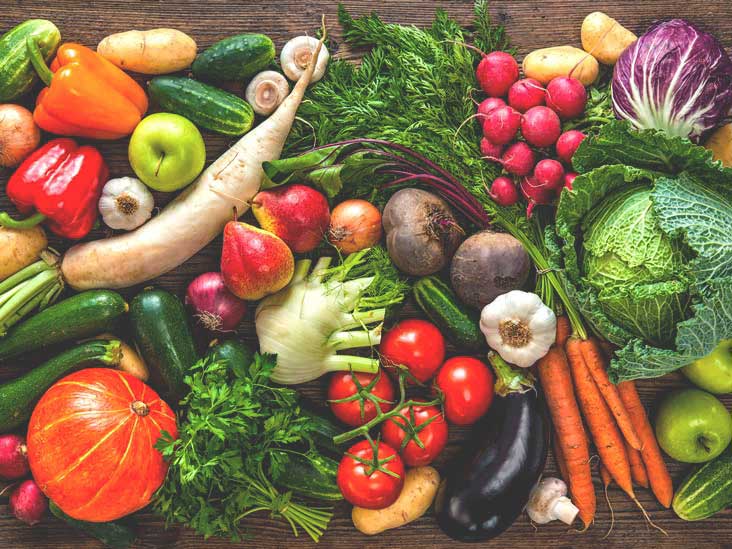
Introduction
This quarter, we’re interested in tackling vegetable intake: that is, we’re interested in the successful behavior interventions that lead towards increased / better vegetable intake and attitudes. As part of our review, we looked to compare a few different solutions introduced in this space (as well as a few solutions outside of this space that we think can inform our approach to vegetable intake, too).
General Secondary Research Findings
We learned from our literature review that there are many factors that contribute to varying amounts of vegetable intake: nutritional knowledge, price, order of consumption, and even shape, size, and addition of condiments. Even seemingly unrelated factors like social context, self-affirmation, and childhood experiences / exposure can affect intake, too. It’s important to keep in mind that vegetable intake trends vary by different demographics (such as race, gender, and age), as well as by inequitable access to produce.
Generally speaking, however, we noticed that people choose to load up on vegetables for the many associated health benefits: fiber intake, improved mental health, improved eyesight and general physical health.
Eating vegetables may seem like an obvious thing to do, but people rarely know how much they should actually be consuming. Studies have shown that we ideally need 2 to 3 cups per day. We are increasingly eating less vegetables (with longitudinal trends indicating that adolescents decreased their daily intake of fruit and vegetables by an average of 0.7 servings during the transition from early to middle adolescence, and by 0.6 servings from middle to late adolescence), so it’s important to find an effective solution in this space.
Below, we document ten representative solutions along with their affordances, drawbacks, and perceived unique value proposition.
Analysis of Existing Comparators
Dr. Greger’s Daily Dozen, app
Dr. Greger’s Daily Dozen is an app that takes a simple, rather open-ended approach to achieving a healthy diet – instead of asking users to limit calories or eliminate certain foods, the app suggests eating from 11 healthy food groups each day (3 of which relate to vegetables: cruciferous vegetables, greens, and other vegetable), and getting a bit of exercise. Within each food category, users will find Dr. Greger’s daily recommended intake as well as his favorites; for cruciferous vegetables, for example, Greger suggests eating 1 cup raw or ½ cup cooked leafy greens such as kale, bok choy, or watercress. The app’s simple interface lets users quickly tally each time they’ve enjoyed a recommended food, and the progress bar motivates users to keep eating healthy throughout the day.
The primary target audience / market for this app are users ages 4+, users who want to eat healthier and practice healthier habits without needing to calorie count or track any macros; “track your food intake without it being a chore.” What differentiates Dr. Greger’s from other health or diet-related apps is that it doesn’t require intense calorie counting or tracking – it acts more as a checklist of what to consume vs provide intense feedback on what you actually consumed. The app’s ease-of-use and non-requirement for manual data entry leads to higher user engagement; users enjoy the passive knowledge about what they should be eating, and the daily progress bar increases users’ motivations. There’s no way for users to view or edit past entries, though, and the lack apps any social engagement or customization.
As mentioned, this app does a great job of creating a non-toxic and non-meticulous way (checklist vs manual entry) of encouraging users to eat healthier – specifically eat certain categories of food each day; however, it doesn’t provide much feedback beyond a daily progress bar, and there’s no socialization. Our app would aim to fill those gaps.
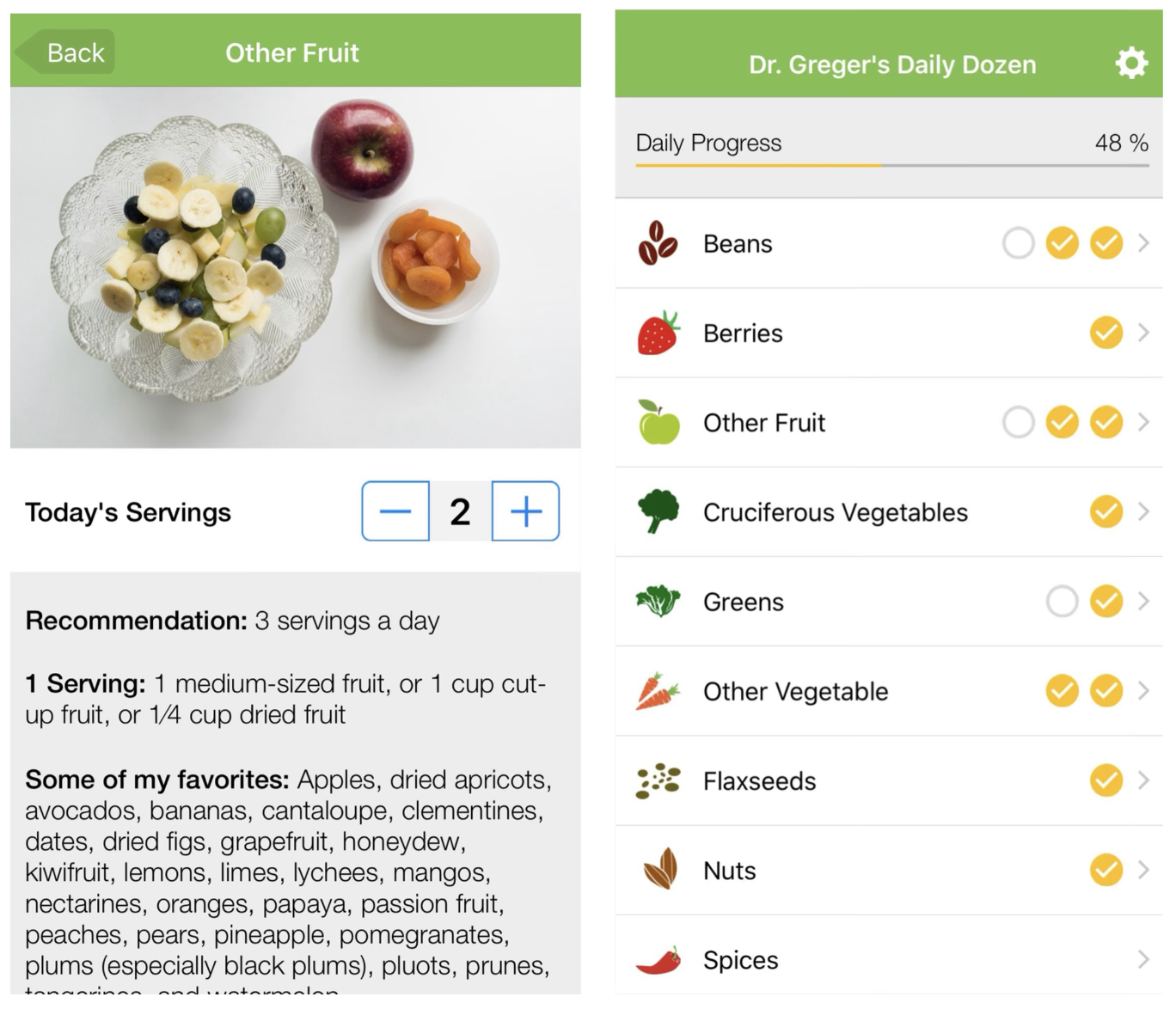
Eat Five, app
Eat Five is an app available on the App Store that allows users to plan meals, create shopping lists, and find recipes. It features a custom meal planner, grocery list maker, and nutrition tracker, as well as a library of recipes from some of the world’s top chefs. The app also includes helpful tips and tricks to help you make healthier food choices. The reviews for Eat Five are generally positive. Many users praise the app’s intuitive design and helpful features. They also appreciate the large selection of recipes available and the ability to customize meal plans. Additionally, many users have noted that the nutrition tracker is an especially helpful tool.
The primary target audience of Eat Five would be health-conscious individuals who are looking for easy and healthy meal ideas. This would include busy professionals, health enthusiasts, and people who are trying to lose weight or maintain a healthier lifestyle. Eat Five is filling both the nutrition & health tracking market and the online food delivery market. Eat Five is unique because, as mentioned above, it combines / merges two markets. Eat Five is easy to use (you can quickly add meals and track your goals with just a few clicks), versatile (can be used for a variety of dietary needs, such as weight loss, muscle gain, or general health), affordable (offers a variety of subscription plans to suit different needs), provides comprehensive tracking of food intake (calories, macronutrients, and micronutrients). Last but not least, Eat Five is connected to a variety of popular fitness and health-tracking apps, such as MyFitnessPal and Fitbit, so users can easily sync their data. Eat Five offers a limited selection of food options, customization options, which can make it difficult for users to create meals that are tailored to their individual preferences, and nutritional information, which can make it difficult for users to make informed decisions about their meals. Furthermore, Eat Five lacks a feedback feature, which means users cannot get feedback on the meals they have created, and a meal planning feature, which can make it difficult for users to plan ahead for their meals. Our solution will improve on the existing app as it is low activation and high feedback, as opposed to Eat Five, which is higher activation and low feedback, unfortunately.
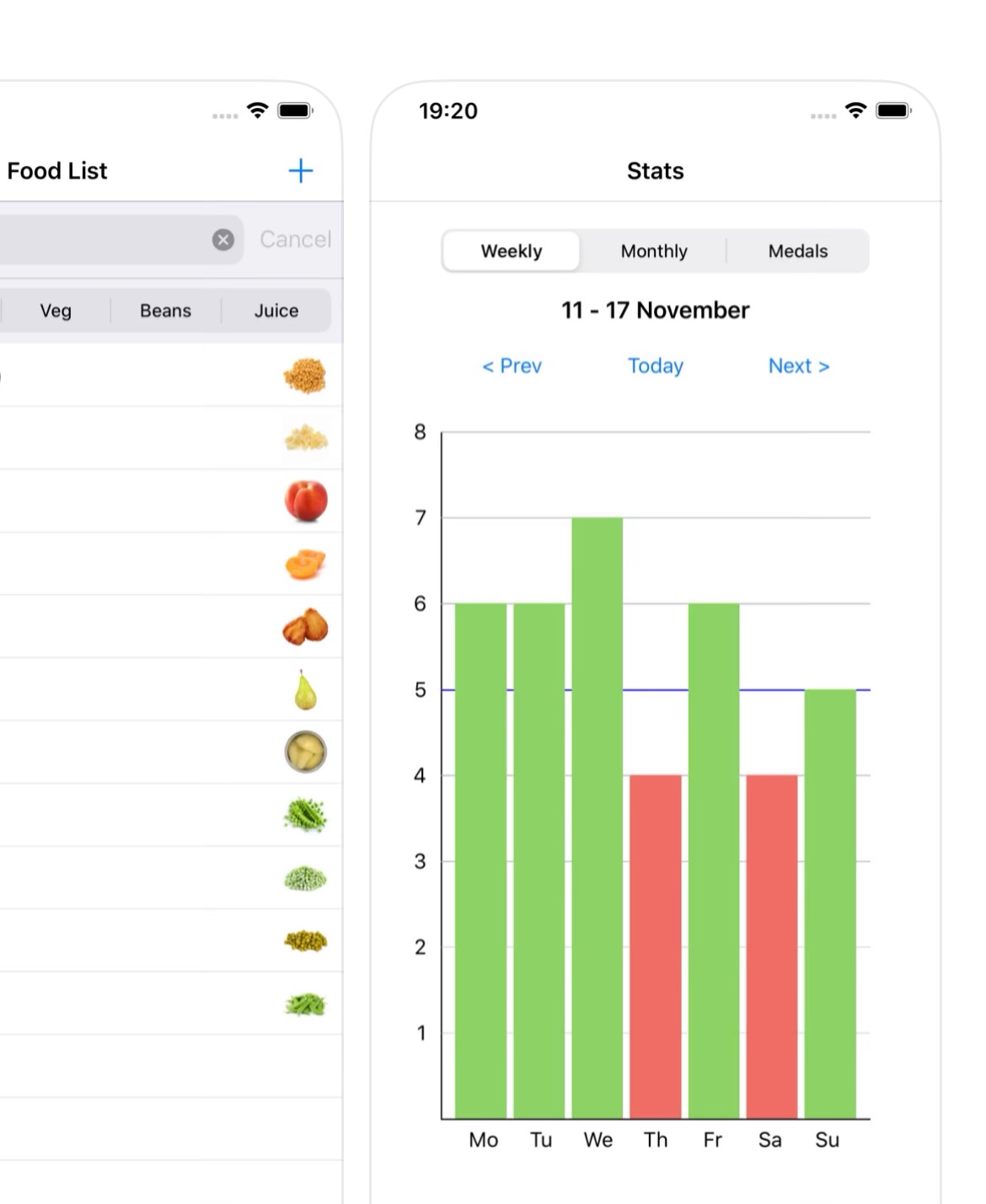
Eat the Rainbow Food Journal, app
Eat the Rainbow Food Journal is an app / daily food journal that helps visualize users’ diets to ensure they are getting a wide range of nutrients from the foods they eat, as the creators believe a good guide to consuming a balanced diet is “eating the rainbow” (the eye-catching colors of fruits and vegetables are intended to serve as a guide for the nutrients they contain). Users can choose daily or weekly targets to increase plant variety, users’ rainbows update dynamically based on which colors they eat (the more one eats, the darker the color shade is), users can tell which colors they are lacking in each day to help guide their next meals, and users also earn unicorns or gold stars when they reach certain goals. The app also has a section / pages to help users learn the science behind what makes someone’s favorite fruits and vegetables so beneficial. Users really enjoy the app’s ease-of-use and fun use of colors, but they have complaints that the app lacks clarity in how much food actually counts as a serving.
The primary target audience / market for this app are users ages 4+, users who want to eat not necessarily more vegetables, but a wider range of vegetables. What differentiates Eat the Rainbow Food Journal from other health or diet-related apps is its focus on a wider range of vegetables, and it’s fun theme / gamification (as mentioned, the eye-catching colors of fruits and vegetables are intended to serve as a guide for the nutrients they contain, and users’ rainbows update dynamically based on which colors they eat). Both the app’s gamification and inclusion of the science behind what makes someone’s favorite fruits and vegetables so beneficial leads to increased user engagement. Users also appreciate the customization aspect of being able to set daily or weekly targets. However, because users can set their own targets, users can cheat themselves; there’s also no clarity around how much food actually counts as a serving, so data is not entirely accurate.
As mentioned, this app does a great job of creatively displaying food intake – the theme and gamification aspects are key. The app’s knowledge aspect also further encourages healthy eating. However, there’s no socialization, which our app would include, along with more feedback than progress towards “completing the rainbow.”
Food Diary, app
Photo Food Diary is a mobile app that functions as a simple and easy-to-use food diary for individuals looking to adopt healthier and more mindful eating habits. The app also has a professional version for doctors, nutritionists, personal trainers, and coaches to help monitor their clients’ food intake by having them share their photo food journals. Their intention is to help users find ease and inspiration in eating habits while avoiding the rigidity of calorie counting. It has a clean interface to view tracked food history. Users appreciate this app because it helps keep them accountable for what they eat, and aids them as visual learners. They also claimed they felt less stressed when tracking their food.
The target audience for this app is people 12+ who want a simple way to track and review their daily food intake. Additionally, it might help individuals who care about what they eat but don’t want to go to the extreme of tracking calories. It mostly fills the health tracking market and is unique because of the emphasis on photos as a form of a diary. Its main strength as an app is that is it very simple and easy to see food consumption at a glance, meaning it has low activation and users can easily get into the habit of doing it. However one of its biggest weaknesses is that it doesn’t provide much feedback about what the user consumes. This app has very low feedback since it doesn’t provide users with any valuable information about what they are eating. It is simply basically a sorted photo album of food. Our app would ideally take the low activation concept from this app (photo-based), but add feedback and nutritional knowledge to accompany it.
Unique value proposition: A simple visually appealing app that helps users monitor their eating habits.
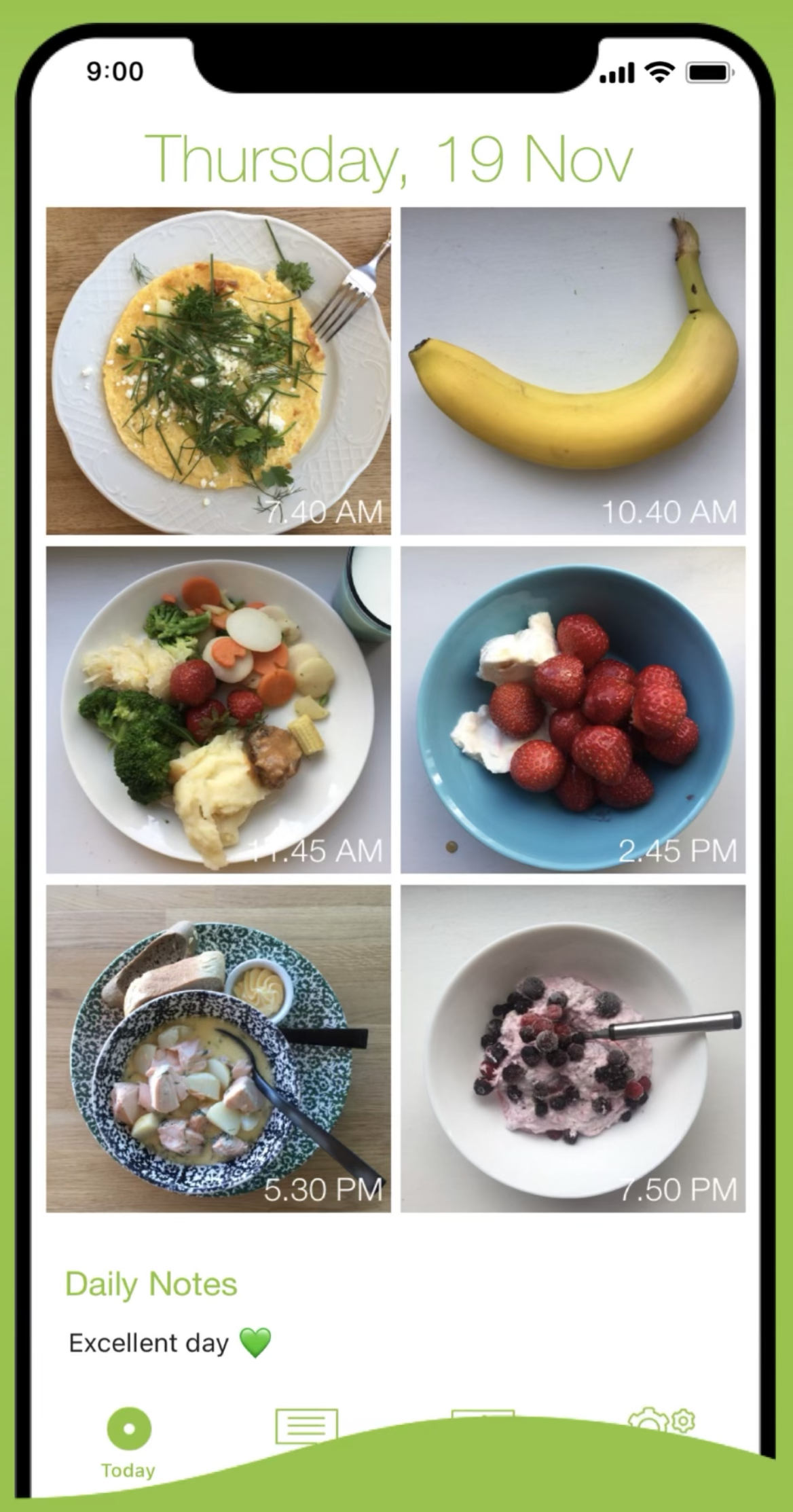
Half My Plate, app
Half My Plate is an app to track both fruit and vegetable intake. The onboarding process asks users for their sex, date of birth, and how physically active they are (less than 30 min daily, 30-60 min daily, or over 60 min daily). Then, using the image of a round plate, the app tracks daily vegetable/fruit intake with pictures and a percentage bar. If a user inputs they’ve eaten grapefruit, the upper left corner of the plate will show then have a grapefruit image; conversely, if a user inputs they’ve eaten broccoli, the plate will show an image of a broccoli in its lower left corner. Together, these categories make up half the visual plate, with grains and proteins constituting the other half. Regardless of category (vegetable vs. fruit), the app will ask for an approximate quantity when logging daily intake, and it gives visual approximations to help users understand how to measure their own food. For example, it states that a portion of ¼ cup is equivalent to a golf ball, and that a ¾ cup portion is equivalent to a tennis ball. Lastly, the app comes with 796 recipes (free of charge) to give users ideas on how to consume more fruits and vegetables.
Half My Plate has a target audience of people seeking to expand their vegetable intake and recipes repertoire. Since most teenagers and children do not cook for themselves or take care of cooking or recipe finding, this app is mostly suited for users 25 and over. It is a unique app in its usage of graphics to visualize users’ daily progress: not only does it show a plate with the target food categories (fruits and vegetables), but it also adds images of specific ingredients the user has logged onto their daily journal. It is a great way to visually motivate users to keep going with their daily intake increase. One of its weaknesses is that although it offers many free recipes, it has no way to filter through them other than a search engine that only finds recipes by name, not ingredients. Our app would improve on daily veggie intake increase by providing more feedback to users with ideas on how they can continue to improve their vegetable intake as time goes by. Additionally, we could recommend recipes based on the most consumed ingredients by the user.
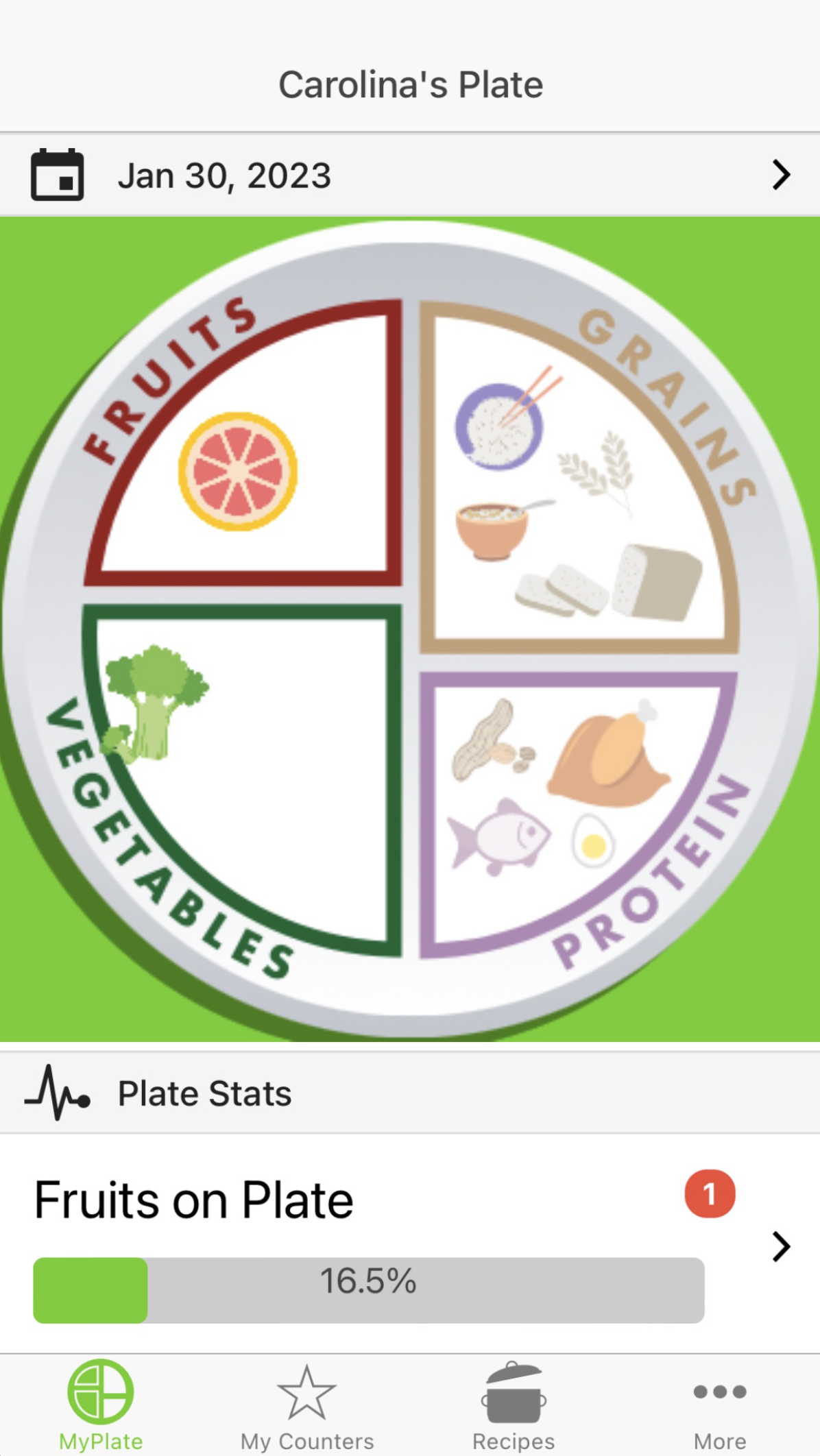
HelloFresh, app
HelloFresh is a meal kit delivery service that provides customers with all the ingredients and recipes needed to prepare healthy, delicious meals at home. The company offers a range of meal plans, including options for families, couples, and individuals, with options for different dietary preferences, such as vegetarian and low-carb. Each week, customers choose the recipes they want to receive, and HelloFresh delivers the ingredients in pre-portioned, insulated packages. The recipes are designed to be easy to follow, and take between 30 minutes and an hour to prepare. HelloFresh aims to make it easy and convenient for customers to eat well and enjoy healthy, home-cooked meals, without the hassle of meal planning and grocery shopping.
HelloFresh caters to a target audience of individuals and households who desire to cook fresh, healthy meals at home but lack the time or desire to plan and purchase ingredients. This meal delivery service makes itself unique by offering pre-portioned, fresh ingredients along with a diverse selection of recipes and customizable meal plans, all while prioritizing sustainability. The convenience of having ingredients delivered and ready to cook saves customers time and effort. HelloFresh sources top-quality ingredients and offers a wide array of dishes, including classic cuisine, international flavors, and vegetarian options for customers to experiment with new meals. The service allows for flexibility, allowing customers to choose from different meal plans and pause or cancel deliveries at any time. The company places importance on being environmentally friendly, utilizing recyclable packaging and sourcing ingredients from sustainable, local sources. Despite its strengths, the cost can be more expensive compared to traditional grocery shopping, particularly for larger families. Additionally, delivery disruptions or delays can impact the quality of the meals. The recipes and ingredients are predetermined, leaving little room for customization to personal tastes or dietary requirements. The app does not provide feedback to help customers improve their vegetable eating habits. This weakness is an area our app aims to address by providing feedback.
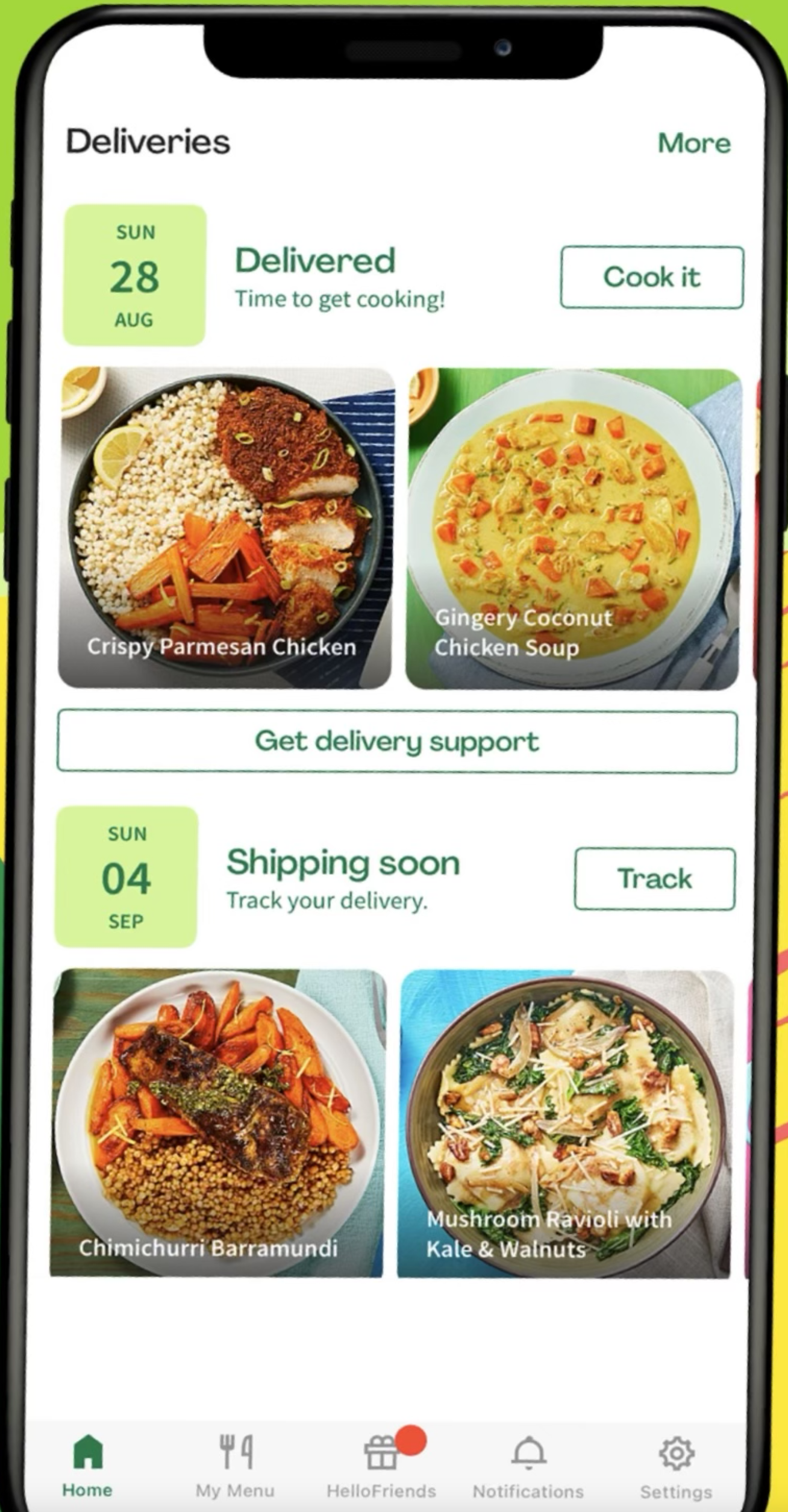
Lifesum, app
Lifesum is a health and wellness app that helps users track their food and drinks intake, monitor their physical activity, and set and achieve health and fitness goals. It provides personalized nutrition and exercise recommendations, and includes features such as a food diary, barcode scanner, and water tracker. Lifesum also offers daily reminders to help users stay on track, and users can sync the app with fitness trackers and scales for a more comprehensive view of their health and fitness. Additionally, the app offers access to a library of recipes, articles and meal plans to help users find healthy food options and achieve their goals. With Lifesum, users can monitor their progress, set and track their goals, and receive support and encouragement along the way.
The target audience of Lifesum are people who aim to enhance their overall well-being and health through healthier habits. This includes those who wish to manage their weight, monitor their nutrition, or simply follow a healthier diet. Lifesum attracts individuals searching for a simple yet effective tool to aid them in their health and wellness journey. The app is distinctive due to its tailored health plans, nutritional tracking, user-friendly interface, and integration with other fitness applications. One of its strong points is its personalization, which makes it easier for users to make healthier choices and reach their goals. Lifesum also allows users to monitor their daily nutritional intake and make informed food choices. The app seamlessly integrates with other fitness apps, giving users an all-encompassing view of their health and wellness journey. The app is designed to be user-friendly and accessible to a wide range of individuals, offering features such as food and exercise tracking, recipe suggestions, and a barcode scanner for quick food tracking. However, there are some drawbacks to Lifesum as well. The app’s food database may not contain all products, especially specialty or international items, and its accuracy depends on the data entered by the user. The app may require a paid subscription for full access to all features, which may be a hindrance for some users, and its functionality for specific diets, such as a ketogenic diet, may be limited. The biggest weakness that our app aims to improve on is its high activation nature. Users have to spend a lot of time inputting each specific intake of food, which our app will not require.

My Daily Plate, app
This app is designed to help users track their meals and activity, as well as access nutrition information, recipes and tips. Reviewers have generally given the app high star ratings, citing its ease of use and helpful features. Many reviewers seem to appreciate the ability to track their meals & activity and the detailed nutrition information provided. Some users find the calorie-counting feature to be helpful and others appreciate the recipes and tips. A few reviewers find the user interface to be confusing/difficult to use.
The primary target audience for My Daily Plate is adults (app store says age 4+) who are interested in making healthier dietary choices. My Daily Plate is also a useful tool for parents and caregivers of children age 2 and over who want to make healthier dietary choices for their families. For the most part, MyPlate is made for people who may lack the time it takes to plan a balanced plate of food for every meal. My Daily Plate is filling the nutrition and health tracking market; it offers a platform for users to track their meals, activities, and health metrics. My Daily Plate is unique because you can track your progress visually instead of deciphering lots of figures. Some of My Daily Plate’s strengths are that it is easy to use and understand (designed with a user-friendly interface and simple navigation), provides personalized meal plans and recipes tailored to your specific dietary needs (making it easier to maintain a healthy diet), automatically tracks your daily food intake and activity levels (making it easy to monitor your progress and stay on track), has visualization of progress (making it easier to track your progress over time). Last but not least, another strength is its connectivity with other apps: it is compatible with other popular fitness and diet tracking apps, making it easier to stay on top of your diet and exercise routine. Besides not being free, My Daily Plate has a couple of weaknesses: a limited food database (the app does not have a comprehensive food database, making it difficult to accurately track food intake and calories), limited tracking (it does not track other important nutrients such as carbohydrates, fats, and proteins), limited meal planning (the app does not provide meal planning capabilities, making it difficult to plan out complete meals), no reminders (the app does not offer any reminders or notifications to help you stay on track with your diet), and no activity tracking. Our solution will improve on the existing app as it will be low activation and high feedback. My Daily Plate does not provide active feedback, it is passive, simply showing you your stats. We hope to produce an app that is much more interactive and effective!
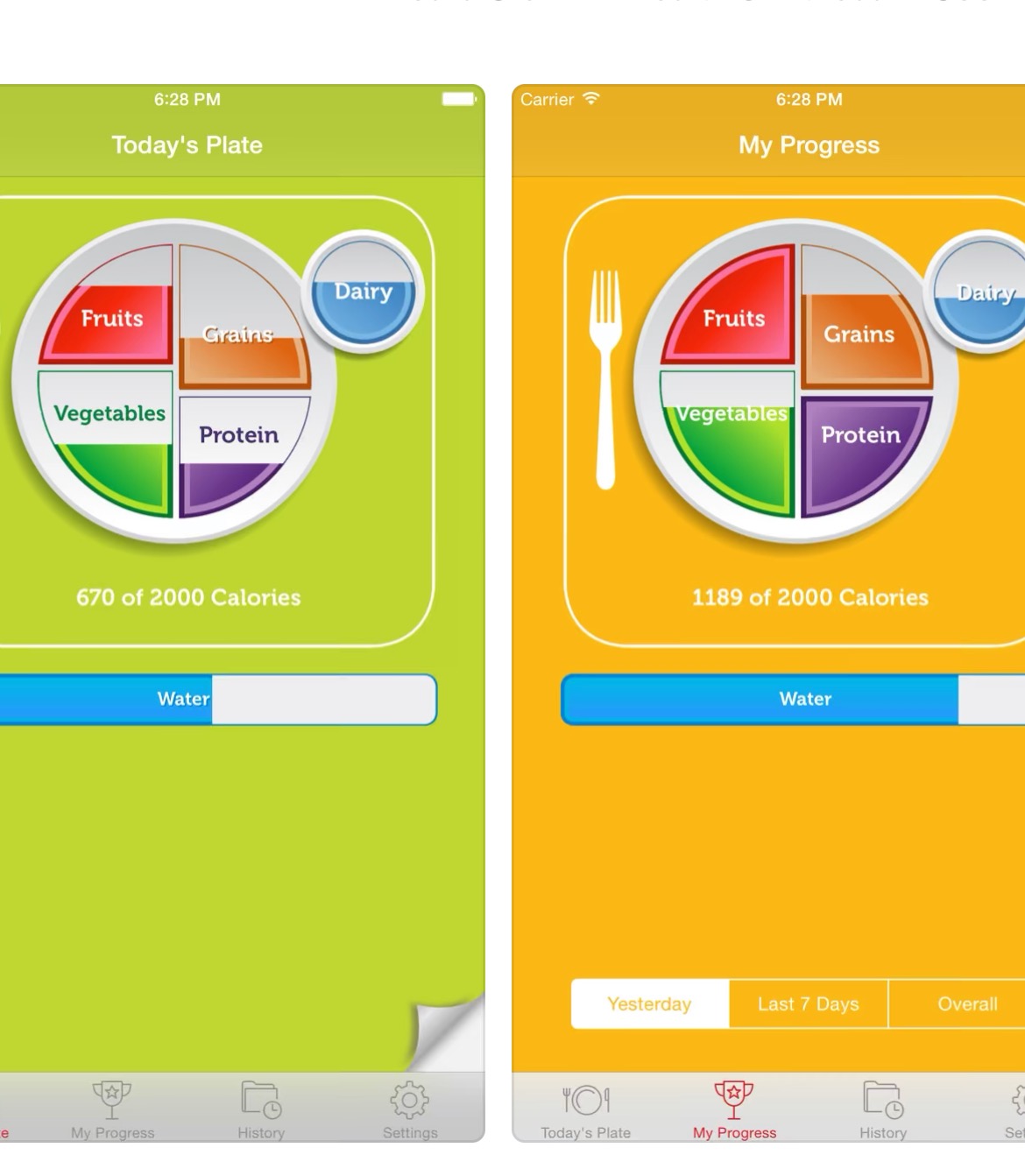
MyFitnessPal, app
MyFitnessPal is a mobile and web app that provides users with a platform for tracking their food intake and monitoring their progress toward their nutrition and fitness goals. The app lets users log food items and track calories, nutrients, and other dietary information. One thing I liked was its intuitive UI lets users manually upload data, or take a picture and have AI identify the meal. The app’s food database contains over 14 million foods, and users can quickly log meals using the barcode scanning feature. The app also gives the user access to a large fitness community for support and advice. One thing that makes it unique is that it offers users other features and tools, such as nutritionist-approved recipes and motivational workout tips. Users love the app because it helps them stay consistent and connects them to a community of people who have similar goals.
The target audience of this app is people 17+ who have specific weight and fitness goals, such as losing weight or gaining muscle mass. It is unique because it is a comprehensive food diary that provides personalized nutrition and fitness guidance. Its major strength is that it has several novel features (scan food to identify, fasting goals, nutrition/macro tracking, recipes) as well as a database with the nutritional information of 14 million foods. However, its main weakness, because of these features, is that it can promote unhealthy eating habits/disorders, especially with calorie tracking. This app has great feedback, as it instantly provides the user with knowledge of the food they are eating. However, because it provides so much information, it can in the long run harm the user if they become too obsessed with numbers. Our solution might keep the level of feedback but focus less on numerical information and more on how it improves well-being (mental, and physical health)
Unique value proposition: A comprehensive food diary and weight loss app that provides users with personalized nutrition and fitness guidance, as well as a food database and community support to help users reach their goals.

VegOut!, app
The VegOut! App takes a more gamified/competitive approach to vegetable eating. It is mostly focused on its 30-day challenge, in which users log their vegetable intake, rate how much they liked it, and then they are given points based on how many vegetables they eat that day. However, the app does not ask for portion size. A plus side is that it has a Friends feature and you can see what vegetables other people are eating and how they’re doing with their own progress, which can help create a sense of community with a shared goal. Lastly, the app also comes with a Badges feature, similar to Apple’s Fitness App that awards badges based on how much a user walked/moved that day. This gamified approach has the potential to engage users and make the goal of eating more vegetables more exciting. A potential downside to the gamified approach is that it can lend itself to contribute to diet culture and become an obsession with tracking rather than eating more vegetables in general.
The VegOut! App is perfect for a younger audience learning to understand the importance of eating vegetables. Its gamified approach makes it well-suited for elementary through high school students. It is unique in its emphasis on social connection and bonding over an increased veggie intake journey. One of its weaknesses is the lack of information regarding portion size. Our app would improve on this targeted behavior change by providing more information on the importance of approximating portions, both for the sake of keeping track but also to motivate oneself by knowing how much you have already eaten in a day. 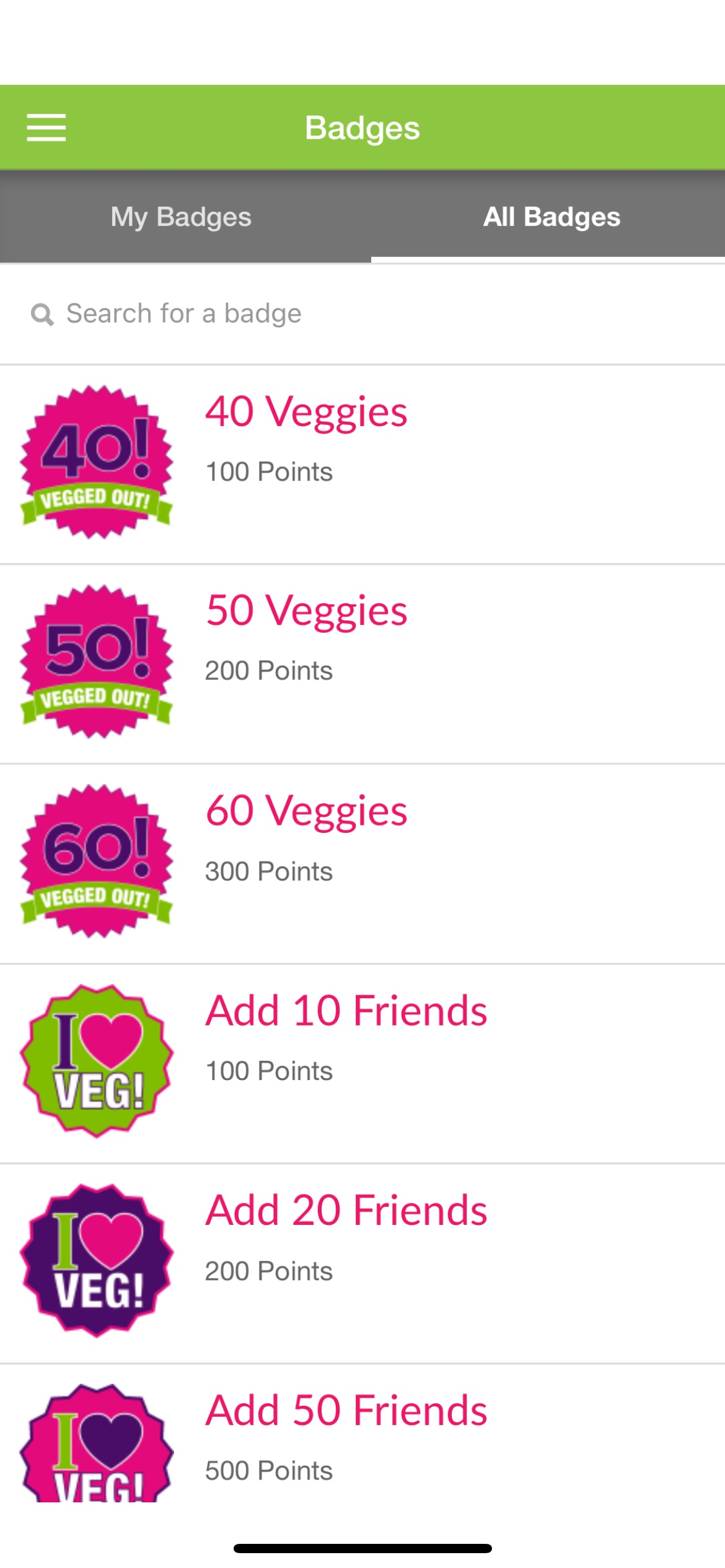
Overview of Existing Comparators
Looking at the various solutions we found, we mapped them on a comparative matrix where we measured activation (that is, the level of effort users must put into tracking and / or changing their vegetable intake) and feedback (the amount of feedback given by the solution).
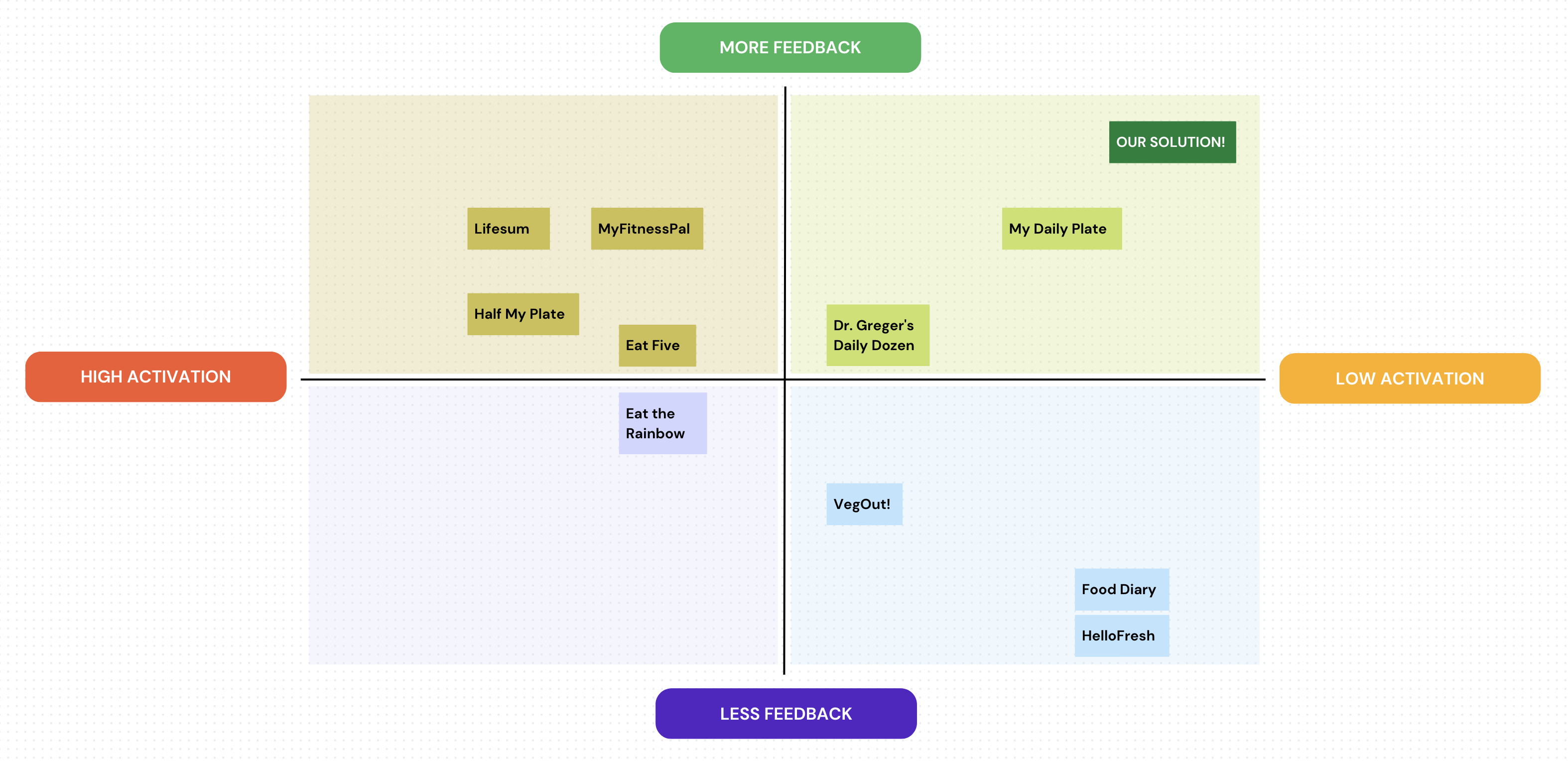
We found that solutions that required high activation provided more feedback (which doesn’t come as a surprise, since higher activation provides developers with more data to analyze / provide feedback on), and similarly, solutions that were low activation provided less feedback.
From this matrix, we’ve tentatively found ourselves interested in developing a solution in the low activation and more feedback space, a solution that makes vegetable intake explicit and natural, and encourages users, via feedback, to build a healthy relationship with eating vegetables. We’d also like to include some socialization aspect to make it more fun, too.

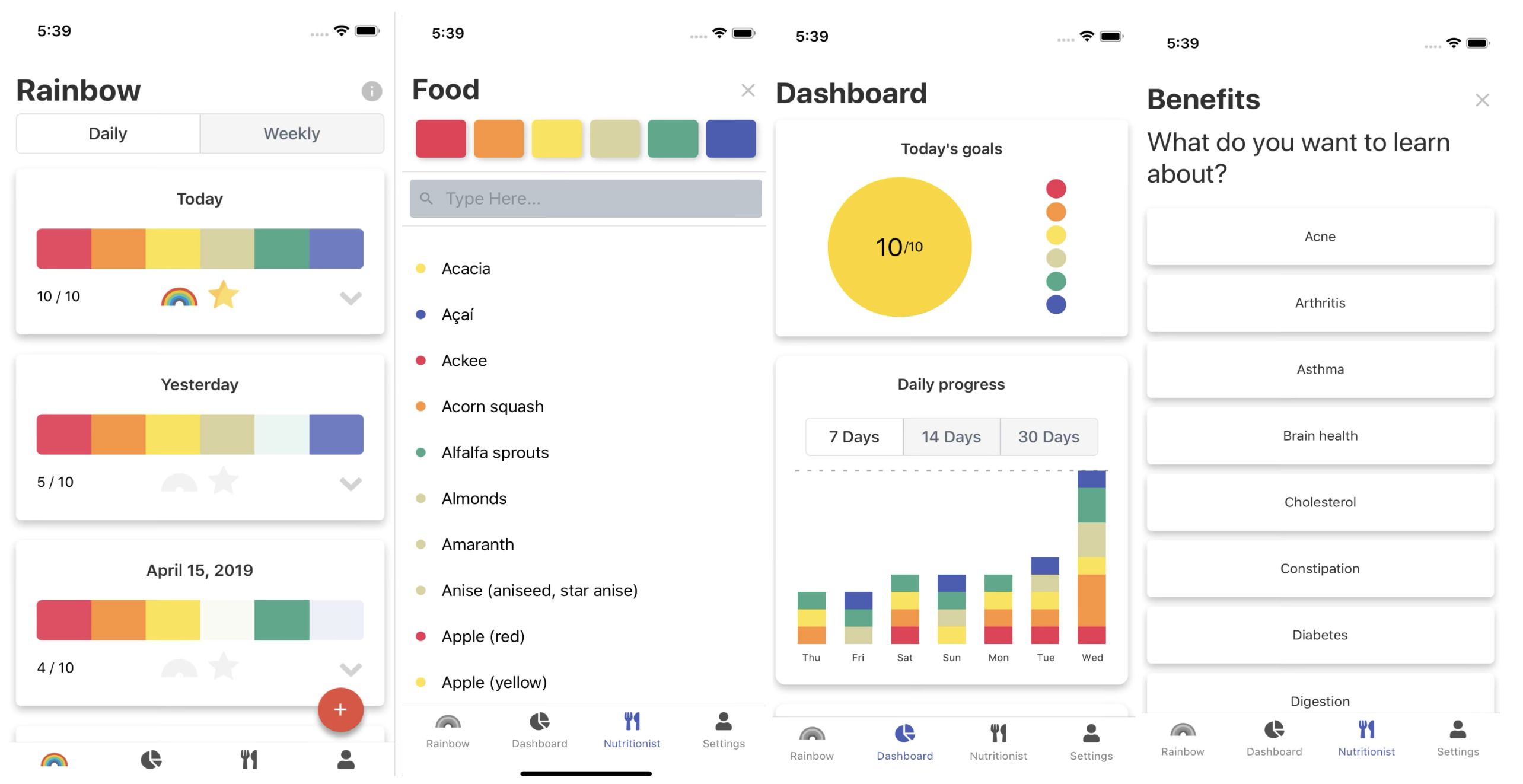



Comments
Comments are closed.